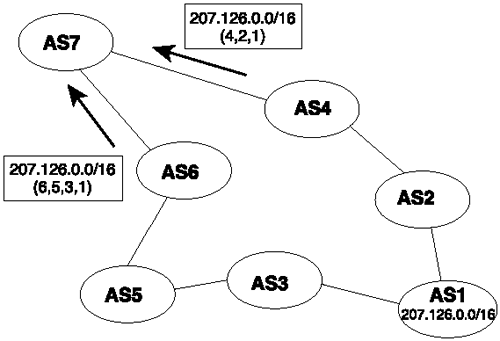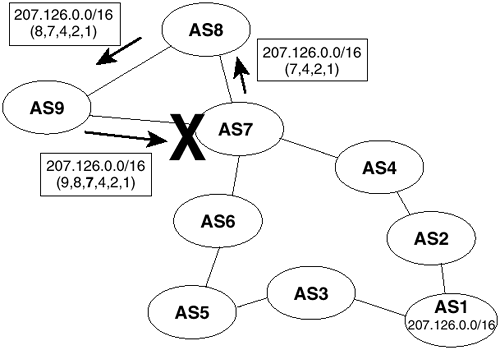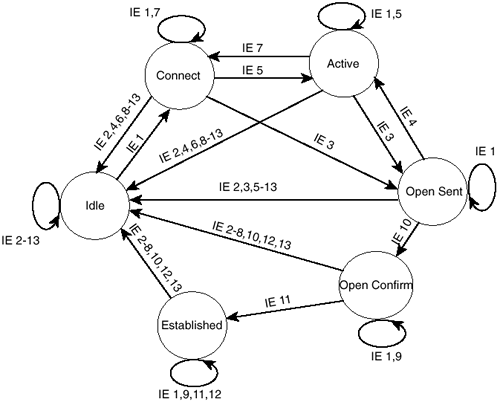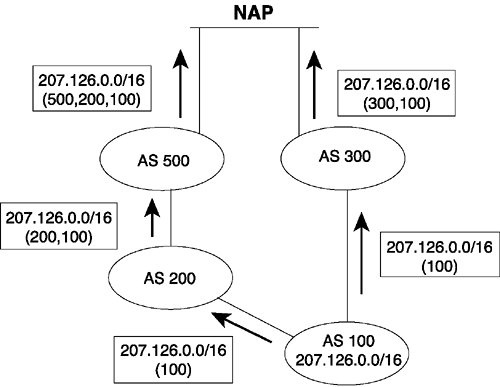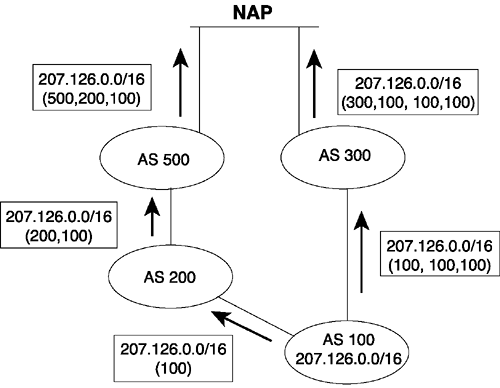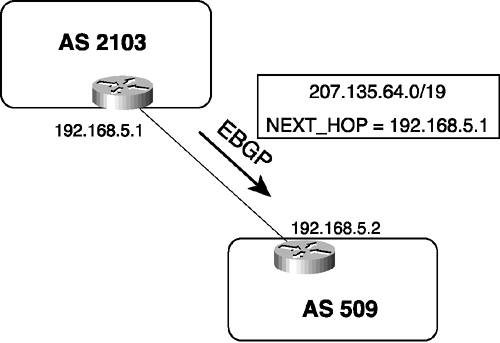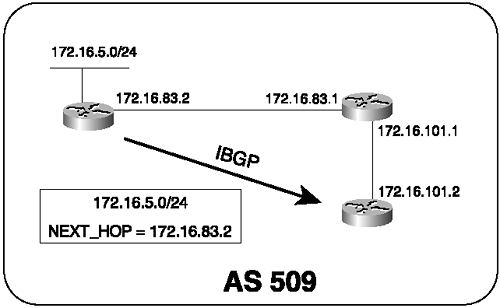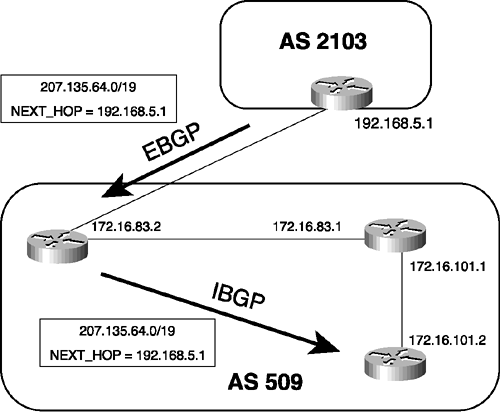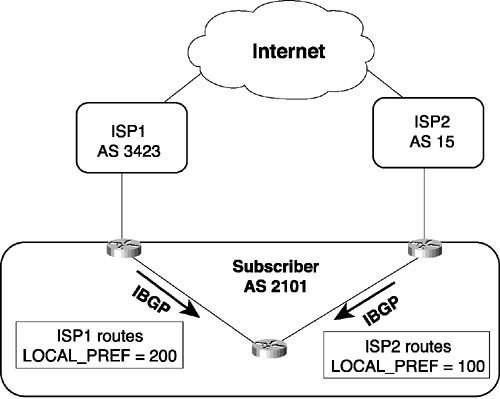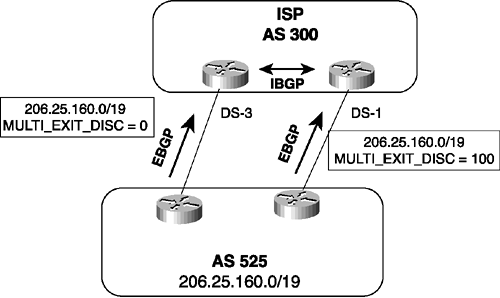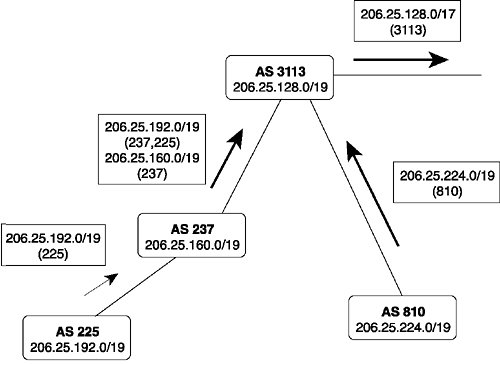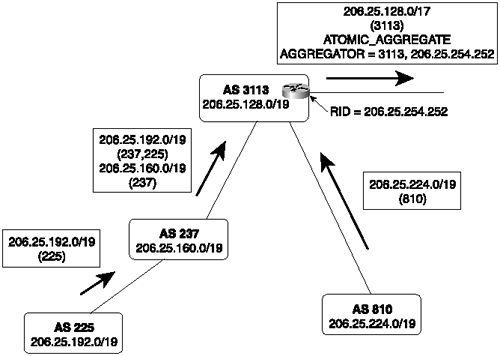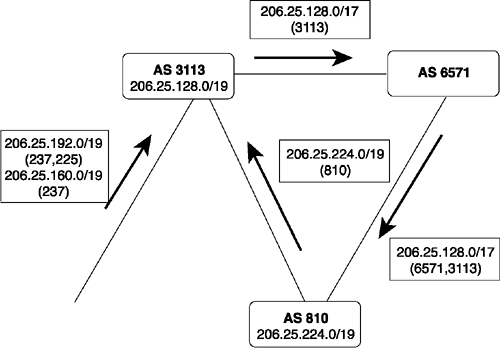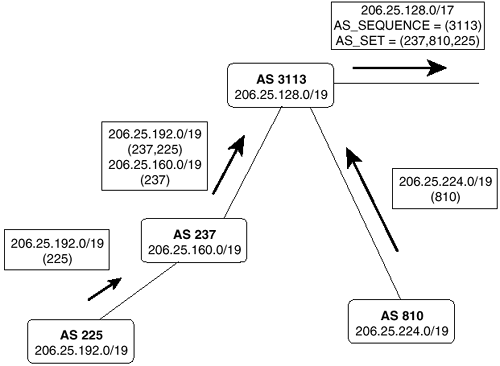BGP Basics
| Like EGP, BGP forms a unique, unicast-based connection to each of its BGP-speaking peers. To increase the reliability of the peer connection, BGP uses TCP (port 179) as its underlying delivery mechanism. The update mechanisms of BGP are also somewhat simplified by allowing the TCP layer to handle such duties as acknowledgment, retransmission, and sequencing. Because BGP rides on TCP, a separate point-to-point connection to each peer must be established. BGP is a distance vector protocol in that each BGP node relies on downstream neighbors to pass along routes from their routing table; the node makes its route calculations based on those advertised routes and passes the results to upstream neighbors. However, other distance vector protocols quantify the distance with a single number, representing hop count or, in the case of IGRP and EIGRP, a sum of total interface delays and lowest bandwidth. In contrast, BGP uses a list of AS numbers through which a packet must pass to reach the destination (see Figure 2-18). Because this list fully describes the path a packet must take, BGP is called a path vector routing protocol to contrast it with traditional distance vector protocols. The list of AS numbers associated with a BGP route is called the AS_PATH and is one of several path attributes associated with each route. Path attributes are described fully in a subsequent section. Figure 2-18. BGP Determines the Shortest Loop-Free Inter-AS Path from a List of AS Numbers Known as the AS_PATH Attribute Recall from Chapter 1 that EGP is not a true routing protocol because it does not have a fully developed algorithm for calculating the shortest path and it cannot detect route loops . In contrast, the AS_PATH attribute qualifies BGP as a routing protocol on both counts. First, the shortest inter-AS path is very simply determined by the least number of AS numbers. In Figure 2-18, AS7 is receiving two routes to 207.126.0.0/16. One of the routes has four AS hops, and the other has three hops. AS7 chooses the shortest path, (4,2,1). Route loops also are very easily detected with the AS_PATH attribute. If a router receives an update containing its local AS number in the AS_PATH, it knows that a routing loop has occurred. In Figure 2-19, AS7 has advertised a route to AS8. AS8 advertises the route to AS9, which advertises it back to AS7. AS7 sees its own number in the AS_PATH and does not accept the update, thereby avoiding a potential routing loop. Figure 2-19. If a BGP Router Sees Its Own AS Number in the AS_PATH of a Route from Another AS, It Rejects the Update BGP does not show the details of the topologies within each AS. Because BGP sees only a tree of autonomous systems, it can be said that BGP takes a higher view of the Internet than IGP, which sees only the topology within an AS. And because this higher view is not really compatible with the view seen by IGPs, Cisco routers maintain a separate routing table to hold BGP routes. Example 2-13 demonstrates a typical BGP routing table viewed with the show ip bgp command. Example 2-13 The show ip bgp Command Displays the BGP Routing Table route-server> show ip bgp BGP table version is 4639209, local router ID is 12.0.1.28 Status codes: s suppressed, d damped, h history, * valid, > best, i - internal Origin codes: i - IGP, e - EGP, ? - incomplete Network Next Hop Metric LocPrf Weight Path * 3.0.0.0 192.205.31.225 0 7018 701 80 i * 192.205.31.161 0 7018 701 80 i *> 192.205.31.33 0 7018 701 80 i * 192.205.31.97 0 7018 701 80 i * 4.0.0.0 192.205.31.225 0 7018 1 i * 192.205.31.161 0 7018 1 i *> 192.205.31.33 0 7018 1 i * 192.205.31.97 0 7018 1 i * 6.0.0.0 192.205.31.226 0 7018 568 721 1455 i * 192.205.31.225 0 7018 568 721 1455 i * 192.205.31.161 0 7018 701 6113 568 721 1455 i *> 192.205.31.34 0 7018 568 721 1455 i * 192.205.31.33 0 7018 568 721 1455 i * 192.205.31.97 0 7018 1239 568 721 1455 i * 9.2.0.0/16 192.205.31.225 0 7018 1 1673 1675 i * 192.205.31.161 0 7018 701 1673 1675 i --More-- Although the BGP routing table in Example 2-13 looks somewhat different from the AS-internal routing table displayed with the show ip route command, the same elements exist. The table shows destination networks, next-hop routers, and a measure by which the shortest path can be selected. The Metric, LocPrf, and Weight columns are discussed later in this section, but what is of interest now is the Path column. This column lists the AS_PATH attributes for each network. Notice that each AS_PATH ends in an i, indicating that the path terminates at an IGP according to the Origin codes legend. Notice also that for each destination network, multiple next hops are listed. Unlike the AS-internal routing table, which lists only the routes currently being used, the BGP table lists all known paths. A > following the * (valid) in the leftmost column indicates which path the router is currently using. This best path is the one with the shortest AS_PATH. When multiple routes have equivalent paths, as in the table of Example 2-13, the router must have some criteria for deciding which path to choose. That decision process is covered later in this section. When there are parallel, equal-cost paths to a particular destination, as in Example 2-13, Cisco's implementation of EBGP by default selects only one path ”in contrast to other IP routing protocols, in which the default is to load balance across up to four paths. As with the other IP routing protocols, the maximum-paths command is used to change the default maximum number of parallel paths in the range from one to six. Note that load balancing works only with EBGP. IBGP can use only one link. The neighbor with which a BGP speaker peers can be either in a different AS or in the same AS. If the neighbor's AS differs , the neighbor is an external peer and the BGP is called external BGP (EBGP). If the neighbor is in the same AS, the neighbor is an i nternal peer and the BGP is called internal BGP (IBGP). A unique set of issues must be confronted when configuring IBGP; those issues are discussed in the section "IBGP and IGP Synchronization." When two neighbors first establish a BGP peer connection, they exchange their entire BGP routing tables. After that, they exchange incremental, partial updates ”that is, they exchange routing information only when something changes, and only information about what changed. Because BGP does not use periodic routing updates, the peers must exchange keepalive messages to ensure that the connection is maintained . The Cisco default keepalive interval is 60 seconds (RFC 1771 does not specify a standard keepalive time); if three intervals (180 seconds) pass without a peer receiving a keepalive message, the peer declares its neighbor down. You can change these intervals with the timers bgp command. BGP Message TypesBefore establishing a BGP peer connection, the two neighbors must perform the standard TCP three-way handshake and open a TCP connection to port 179. TCP provides the fragmentation, retransmission, acknowledgment, and sequencing functions necessary for a reliable connection, relieving BGP of those duties. All BGP messages are unicast to the one neighbor over the TCP connection. BGP uses four message types:
This section describes how these messages are used; for a complete description of the message formats and the variables of each message field, see the section "BGP Message Formats." Open MessageAfter the TCP session is established, both neighbors send Open messages. Each neighbor uses this message to identify itself and to specify its BGP operational parameters. The Open message includes the following information:
Keepalive MessageIf a router accepts the parameters specified in its neighbor's Open message, it responds with a Keepalive. Subsequent Keepalives are sent every 60 seconds by Cisco default, or a period equal to one-third the agreed-upon hold time. Update MessageThe Update message advertises feasible routes, withdrawn routes, or both. The Update message includes the following information:
Note that although multiple prefixes might be included in the NLRI field, each update message describes only a single BGP route (because the path attributes describe only a single path, but that path might lead to multiple destinations). This, again, emphasizes that BGP takes a higher view of an internetwork than an IGP, whose routes always lead to a single destination IP address. Notification MessageThe Notification message is sent whenever an error is detected and always causes the BGP connection to close. The section "BGP Message Formats" includes a list of possible errors that can cause a Notification message to be sent. An example of the use of a Notification message is the negotiation of a BGP version between neighbors. If, after establishing a TCP connection, a BGP-3 speaker receives an Open message specifying version 4, the router responds with a Notification message stating that the version is not supported. The connection is closed, and the neighbor attempts to reestablish a connection with BGP-3. The BGP Finite State MachineThe stages of a BGP connection establishment and maintenance can be described in terms of a finite state machine. Figure 2-20 and Table 2-4 show the complete BGP finite state machine and the input events that can cause a state transition. Figure 2-20. The BGP Finite State Machine Table 2-4. The Input Events (IE) of Figure 2-20
The following sections provide a brief description of each of the six states illustrated in Figure 2-20. Idle StateBGP always begins in the Idle state, in which it refuses all incoming connections. When a Start event (IE 1) occurs, the BGP process initializes all BGP resources, starts the ConnectRetry timer, initializes a TCP connection to the neighbor, listens for a TCP initialization from the neighbor, and changes its state to Connect. The Start event is caused by an operator configuring a BGP process or resetting an existing process, or by the router software resetting the BGP process. An error causes the BGP process to transition to the Idle state. From there, the router may automatically try to issue another Start event. However, limitations should be imposed on how the router does this ”constantly trying to restart in the event of persistent error conditions causes flapping. Therefore, after the first transition back to the Idle state, the router sets the ConnectRetry timer and cannot attempt to restart BGP until the timer expires . Cisco's initial ConnectRetry time is 60 seconds. The ConnectRetry time for each subsequent attempt is twice the previous time, meaning that consecutive wait times increase exponentially. Connect StateIn this state, the BGP process is waiting for the TCP connection to be completed. If the TCP connection is successful, the BGP process clears the ConnectRetry timer, completes initialization, sends an Open message to the neighbor, and transitions to the OpenSent state. If the TCP connection is unsuccessful , the BGP process continues to listen for a connection to be initiated by the neighbor, resets the ConnectRetry timer, and transitions to the Active state. If the ConnectRetry timer expires while in the Connect state, the timer is reset, another attempt is made to establish a TCP connection with the neighbor, and the process stays in the Connect state. Any other input event causes a transition to Idle. Active StateIn this state, the BGP process is trying to initiate a TCP connection with the neighbor. If the TCP connection is successful, the BGP process clears the ConnectRetry timer, completes initialization, sends an Open message to the neighbor, and transitions to OpenSent. The Hold timer is set to 4 minutes. If the ConnectRetry timer expires while BGP is in the Active state, the process transitions back to the Connect state and resets the ConnectRetry timer. It also initiates a TCP connection to the peer and continues to listen for connections from the peer. If the neighbor is attempting to establish a TCP session with an unexpected IP address, the ConnectRetry timer is reset, the connection is refused , and the local process stays in the Active state. Any other input event (except a start event, which is ignored in the Active state) causes a transition to Idle. OpenSent StateIn this state, an Open message has been sent, and BGP is waiting to hear an Open from its neighbor. When an Open message is received, all its fields are checked. If errors exist, a Notification message is sent and the state transitions to Idle. If no errors exist in the received Open message, a Keepalive message is sent and the Keepalive timer is set. The Hold time is negotiated, and the smaller value is agreed upon. If the negotiated Hold time is zero, the Hold and Keepalive timers are not started. The peer connection is determined to be either internal or external, based on the peer's AS number, and the state is changed to OpenConfirm. If a TCP disconnect is received, the local process closes the BGP connection, resets the ConnectRetry timer, begins listening for a new connection to be initiated by the neighbor, and transitions to Active. Any other input event (except a start event, which is ignored) causes a transition to Idle. OpenConfirm StateIn this state, the BGP process waits for a Keepalive or Notification message. If a Keepalive is received, the state transitions to Established. If a Notification is received, or a TCP disconnect is received, the state transitions to Idle. If the Hold timer expires, an error is detected, or a Stop event occurs, a Notification is sent to the neighbor and the BGP connection is closed, changing the state to Idle. Established StateIn this state, the BGP peer connection is fully established and the peers can exchange Update, Keepalive, and Notification messages. If an Update or Keepalive message is received, the Hold timer is restarted (if the negotiated hold time is nonzero). If a Notification message is received, the state transitions to Idle. Any other event (again, except for the Start event, which is ignored) causes a Notification to be sent and the state to transition to Idle. Path AttributesA path attribute is a characteristic of an advertised BGP route. Some path attributes are familiar, such as the destination IP address and the next-hop router, because they are a common characteristic of all routes. Others, such as the ATOMIC_AGGREGATE, are unique to BGP and might be unfamiliar. In addition to providing the information necessary for basic routing functionality, the path attributes are what allow BGP to set and communicate routing policy. Each path attribute falls into one of four categories:
From the names of these four categories, you can see that two subclasses exist and that each subclass has its own subclass. First, an attribute is either well-known, meaning that it must be recognized by all BGP implementations , or it is optional, meaning that the BGP implementation is not required to support the attribute. Well-known attributes are either mandatory, meaning that they must be included in all BGP Update messages, or they are discretionary, meaning that they may or may not be sent in a specific Update message. If an optional attribute is transitive, a BGP process should accept the path in which it is included, even if it doesn't support the attribute, and it should pass the path on to its peers. If an optional attribute is nontransitive, a BGP process that does not recognize the attribute can quietly ignore the Update in which it is included and not advertise the path to its other peers. Table 2-5 lists the path attributes, and following sections describe the use of each attribute. Chapter 3, "Configuring and Troubleshooting Border Gateway Protocol 4," demonstrates the configuration, filtering, and manipulation of the path attributes. Table 2-5. Path Attributes [*]
The ORIGIN AttributeORIGIN is a well-known mandatory attribute that specifies the origin of the routing update. When BGP has multiple routes, it uses the ORIGIN as one factor in determining the preferred route. It specifies one of the following origins:
The AS_PATH AttributeAS_PATH is a well-known mandatory attribute that uses a sequence of AS numbers to describe the inter-AS path, or route, to the destination specified by the NLRI. When a BGP speaker originates a route ”when it advertises NLRI about a destination within its own AS ”it adds its AS number to the AS_PATH. As subsequent BGP speakers advertise the route to external peers, they prepend their own AS numbers to the AS_PATH (see Figure 2-21). The result is that the AS_PATH describes all the autonomous systems it has passed through, beginning with the most recent AS and ending with the originating AS. Figure 2-21. AS Numbers Are Prepended (Added to the Front of) the AS_PATH Note that a BGP router adds its AS number to the AS_PATH only when an Update is sent to a neighbor in another AS. That is, an AS number is prepended to the AS_PATH only when the route is being advertised between EBGP peers. If the route is being advertised between IBGP peers ”peers within the same autonomous system ”no AS number is added. Usually, having multiple instances of the same AS number on the list would make no sense and would defeat the purpose of the AS_PATH attribute. In one case, however, adding multiple instances of a particular AS number to the AS_PATH proves useful. Remember that outgoing route advertisements directly influence incoming traffic. Normally, the route from the NAP to AS 100 in Figure 2-21 passes through AS 300 because the AS_PATH of that route is shorter. But what if the link to AS 200 is AS 100's preferred path for incoming traffic? The links along the (500,200,100) path might all be DS3, for example, whereas the links along the (300,100) path are only DS1. Or perhaps AS 200 is the primary provider, and AS 300 is only the backup provider. Outgoing traffic is sent to AS 200, so it is desired that incoming traffic follow the same path. AS 100 can influence its incoming traffic by changing the AS_PATH of its advertised route (see Figure 2-22). By adding multiple instances of its own AS number to the list sent to AS 300, AS 100 can make routers at the NAP think that the (500,200,100) path is the shorter path. The procedure of adding extra AS numbers to the AS_PATH is called AS path prepending. Figure 2-22. AS 100 Has Begun the AS_PATH Advertised to AS 300 with Multiple Instances of Its Own AS Number The other function of the AS_PATH attribute, as discussed earlier in the chapter, is loop avoidance . The mechanism is very simple: If a BGP router receives a route from an external peer whose AS_PATH includes its own AS number, the router knows that the route has looped. Such a route is dropped. The NEXT_HOP AttributeAs the name implies, this well-known mandatory attribute describes the IP address of the next-hop router on the path to the advertised destination. The IP address described by the BGP NEXT_HOP attribute is not always the address of a neighboring router. The following rules apply:
Figure 2-23 illustrates the first rule. Here, the advertising router and receiving router are in different autonomous systems. The NEXT_HOP is the interface address of the external peer. So far, this behavior is the same as would be expected of any routing protocol. Figure 2-23. If a BGP Update Is Advertised via EBGP, the NEXT_HOP Attribute Is the IP Address of the External Peer Figure 2-24 illustrates the second rule. This time, the advertising router and the receiving router are in the same AS, and the destination being advertised is also in the AS. The NEXT_HOP associated with the NLRI is the IP address of the originating router. Figure 2-24. If a BGP Update Is Advertised via IBGP, and the Advertised Destination Is in the Same AS, the NEXT_HOP Attribute Is the IP Address of the Originating Router Notice that the advertising router and the receiving router do not share a common data link, but the IBGP TCP connection is passed through an IGP-speaking router. This is discussed in more detail in the section "Internal BGP"; for now, the important point is that the receiving router must perform a recursive route lookup (recursive lookups are discussed in Routing TCP/IP, Volume I ) to send a packet to the advertised destination. First, it looks up the destination 172.16.5.30; that route indicates a next hop of 172.16.83.2. Because that IP address does not belong to one of the router's directly connected subnets, the router must then look up the route to 172.16.83.2. That route, learned via the IGP, indicates a next hop of 172.16.101.1. The packet can now be forwarded. This example is very important for understanding the dependency of IBGP on the IGP. Figure 2-25 illustrates the third rule. Here, a route has been learned via EBGP and is then passed to an internal peer. Because the destination is in a different AS, the NEXT_HOP of the route passed across the IBGP connection is the interface of the external router from which the route was learned. Figure 2-25. If a BGP Update Is Advertised via IBGP, and the Advertised Destination Is in a Different AS, the NEXT_HOP Attribute Is the IP Address of the External Peer from Which the Route Was Learned In Figure 2-25, the IBGP peer must perform a recursive route lookup to forward a packet to 207.135.64.0/19. However, a potential problem exists. The network 192.168.5.0, to which the next-hop address belongs, is not part of AS 509. Unless the AS border router advertises the network into AS 509, the IGP ”and hence the internal peers ”will not know about this network. And if the network is not in the routing tables, the next-hop address for 207.135.64.0/19 is unreachable, and packets for that destination are dropped. In fact, although the route to 207.135.64.0/19 is installed in the internal peer's BGP table, it is not installed in the IGP routing table, because the next-hop address is invalid for that router. The first solution to the problem is, of course, to ensure that the external network linking the two autonomous systems is known to the internal routers. Although you could use static routes, the practical method is to run the IGP in passive mode on the external interfaces. In some cases, this might be undesirable. The second solution is to use a configuration option to cause the AS border router in AS 509 to set its own IP address in the NEXT_HOP attribute, in place of the IP address of the external peer. The internal peers would then have a next-hop router address of 172.16.83.2, which is known to the IGP. This configuration option, called next-hop-self, is demonstrated in Chapter 3. The LOCAL_PREF AttributeLOCAL_PREF is short for local preference. This well-known discretionary attribute is used only in updates between internal BGP peers; it is not passed to other autonomous systems. The attribute is used to communicate a BGP router's degree of preference for an advertised route. If an internal BGP speaker receives multiple routes to the same destination, it compares the LOCAL_PREF attributes of the routes. The route with the highest LOCAL_PREF is selected. Figure 2-26 demonstrates how the LOCAL_PREF attribute is used. AS 2101 is taking routes from two ISPs, but ISP1 is the preferred service provider. The router connected to ISP1 advertises the routes from that provider with a LOCAL_PREF of 200, and the router connected to ISP2 advertises the routes from that provider with a LOCAL_PREF of 100 (the default value). All internal peers, including the router attached to ISP2, prefer the routes learned from ISP1 over routes to the same destinations learned from ISP2. Figure 2-26. The LOCAL_PREF Attribute Communicates a Degree of Preference to Internal Peers, with the Higher Value Preferred The MULTI_EXIT_DISC AttributeThe LOCAL_PREF attribute affects only traffic leaving the AS. To influence incoming traffic, the MULTI_EXIT_DISC attribute, known as the MED for short, is used. This optional nontransitive attribute is carried in EBGP updates and allows an AS to inform another AS of its preferred ingress points. If all else is equal, an AS receiving multiple routes to the same destination compare the MEDs of the routes. Unlike LOCAL_PREF, in which the largest value is preferred, the lowest MED value is preferred. This is because MED is considered a metric, and with a metric the lowest value ”the lowest distance ”is preferred. NOTE In BGP-2 and BGP-3, the MULTI_EXIT_DISC attribute is called the INTER_AS metric. Figure 2-27 shows how you can use the MED. Here, a subscriber is dual- homed to a single ISP. AS 525 prefers that its incoming traffic use the DS-3 link, with the DS-1 link used only for backup. The MED in the updates passing across the DS-3 link is set to 0 (the default), and the MED in the updates passing across the DS-1 link is set to 100. If nothing else differs in the two routes, the ISP prefers the DS-3 link, with the lower MED. Figure 2-27. The Lower MED Associated with Routes Passed Over the DS-3 Link Causes the ISP to Prefer This Link Notice that within the ISP, IBGP is being used between the routers. The MEDs from AS 525 are passed between these internal peers so that they both know which route to prefer. However, MEDs are not passed beyond the receiving AS. If the ISP advertises 206.25.160.0/19 to another AS, for example, it does not pass along the MED set by the originating AS. This means that MEDs are used only to influence traffic between two directly connected autonomous systems; to influence route preferences beyond the neighboring AS, the AS_PATH attribute must be manipulated, as shown earlier in this section. MEDs also are not compared if two routes to the same destination are received from two different autonomous systems. If the ISP in Figure 2-27 receives advertisements of 206.25.160.0/19 not only from AS 525 but also from another AS, for example, the MEDs from the two autonomous systems are not compared. MEDs are meant only for a single AS to demonstrate a degree of preference when it has multiple ingress points. The ATOMIC_AGGREGATE and AGGREGATOR AttributesA BGP-speaking router can transmit overlapping routes to another BGP speaker. Overlapping routes are nonidentical routes that point to the same destination. For example, the routes 206.25.192.0/19 and 206.25.128.0/17 are overlapping. The first route is included in the second route, although the second route also points to other more-specific routes besides 206.25.192.0/19. When making a best-path decision, a router always chooses the more-specific path. When advertising routes, however, the BGP speaker has several options for dealing with overlapping routes:
Earlier, this chapter emphasized that when summarization (route aggregation) is performed, some route information is lost and routing can become less precise. When aggregation is performed in a BGP-speaking router, the information that is lost is path detail. Figure 2-28 illustrates this loss of path detail. Figure 2-28. Aggregating BGP Routes Results in the Loss of Path Information AS 3113 is advertising an aggregate address representing addresses in several autonomous systems. Because that AS is originating the aggregate, it includes only its own number in the AS_PATH. The path information to some of the more-specific prefixes represented by the aggregate is lost. ATOMIC_AGGREGATE is a well-known discretionary attribute that is used to alert downstream routers that a loss of path information has occurred. Any time a BGP speaker summarizes more-specific routes into a less-specific aggregate (the fifth option in the preceding list), and path information is lost, the BGP speaker must attach the ATOMIC_AGGREGATE attribute to the aggregate route. Any downstream BGP speaker that receives a route with the ATOMIC_AGGREGATE attribute cannot make any NLRI information of that route more specific, and when advertising the route to other peers, the ATOMIC_AGGREGATE attribute must remain attached. When the ATOMIC_AGGREGATE attribute is set, the BGP speaker has the option of also attaching the AGGREGATOR attribute. This optional transitive attribute provides information about where the aggregation was performed by including the AS number and the IP address of the router that originated the aggregate route (see Figure 2-29). Cisco's implementation of BGP inserts the BGP router ID as the IP address in the attribute. Figure 2-29. The ATOMIC_AGGREGATE Attribute Indicates That a Loss of Path Information Has Occurred, and the AGGREGATOR Attribute Indicates Where the Aggregation Occurred The COMMUNITY AttributeCOMMUNITY is an optional transitive attribute that is designed to simplify policy enforcement. Originally a Cisco-specific attribute, it is now standardized in RFC 1997[8]. The COMMUNITY attribute identifies a destination as a member of some community of destinations that share one or more common properties. For example, an ISP might assign a particular COMMUNITY attribute to all of its customers' routes. The ISP can then set its LOCAL_PREF and MED attributes based on the COMMUNITY value rather than on each individual route. The COMMUNITY attribute is a set of four octet values. RFC 1997 specifies that the first two octets are the autonomous system and the last two octets are an administratively defined identifier, giving a format of AA:NN. The default Cisco format, on the other hand, is NN:AA. You can change this default to the RFC 1997 format with the command ip bgp-community new-format. Suppose, for example, a route from AS 625 has a COMMUNITY identifier of 70. The COMMUNITY attribute, in the AA:NN format, is 625:70 and is represented in hex as a concatenation of the two numbers: 0x02710046, where 625 = 0x0271 and 70 = 0x0046. The RFCs use the hex representation, but COMMUNITY attribute values are represented on Cisco routers in decimal. For example, 625:70 is 40960070 (the decimal equivalent of 0x2710046). The community values from 0 (0x00000000) to 65535 (0x0000FFFF) and from 4294901760 (0xFFFF0000) to 4294967295 (0xFFFFFFFF) are reserved. Out of this reserved range, several well-known communities are defined:
Chapter 3 provides examples of using communities to help enforce routing policies. The ORIGINATOR_ID and CLUSTER_LIST AttributesORIGINATOR_ID and CLUSTER_LIST are optional, nontransitive attributes used by route reflectors, which are described in the section "Managing Large-Scale BGP Peering." Both attributes are used to prevent routing loops. The ORIGINATOR_ID is a 32-bit value created by a route reflector. The value is the router ID of the originator of the route in the local AS. If the originator sees its RID in the ORIGINATOR_ID of a received route, it knows that a loop has occurred, and the route is ignored. CLUSTER_LIST is a sequence of route reflection cluster IDs through which the route has passed. If a route reflector sees its local cluster ID in the CLUSTER_LIST of a received route, it knows that a loop has occurred, and the route is ignored. Administrative WeightAdministrative weight is a Cisco-specific BGP parameter that applies only to routes within an individual router. It is not communicated to other routers. The weight is a number between 0 and 65,535 that can be assigned to a route; the higher the weight, the more preferable the route. When choosing a best path, the BGP decision process considers weight above all other route characteristics except specificity. By default, all routes learned from a peer have a weight of 0, and all routes generated by the local router have a weight of 32,768. Administrative weights can be set for individual routes, or for routes learned from a specific neighbor. For example, peer A and peer B might be advertising the same routes to a BGP speaker. By assigning a higher weight to the routes received from peer A, the BGP speaker prefers the routes through that peer. This preference is entirely local to the single router; weights are not included in the BGP updates or in any other way communicated to the BGP speaker's peers. AS_SETThe AS_PATH attribute has been presented so far as consisting of an ordered sequence of AS numbers that describes the path to a particular destination. There are actually two types of AS_PATH:
These two types are distinguished in the AS_PATH attribute with a type code, as described in the section "BGP Message Formats." NOTE There are, in fact, four types of AS_PATH. See the section "Confederations" for details on the other two types: AS_CONFED_SEQUENCE and AS_CONFED_SET. Recall that one of the major benefits of the AS_PATH is loop prevention. If a BGP speaker sees its own AS number in a received route from an external peer, it knows that a loop has occurred and ignores the route. When aggregation is performed, however, as in Figure 2-28, some AS_PATH detail is lost. As a result, the potential for a loop increases . Suppose, for example, AS 810 in Figure 2-28 has an alternate connection to another AS (see Figure 2-30). The aggregate from AS 3113 is advertised to AS 6571, and from there back to AS 810. Figure 2-30. The Loss of Path Detail When Aggregating Can Cause Inter-AS Routing Loops Because the AS numbers "behind" the aggregation point are not included in the AS_PATH, AS 810 does not detect the potential loop. Next, suppose a network within AS 810, such as 206.25.225.0/24, fails. The routers within that AS will match the aggregate route from AS 6571, and a loop occurs. If you think about it, the loop-prevention function of the AS_PATH does not require that the AS numbers be included in any particular order. All that is necessary is that a receiving router be able to recognize whether its own AS number is a part of the AS_PATH. This is where AS_SET comes in. When a BGP speaker creates an aggregate from NLRI learned from other autonomous systems, it can include all those AS numbers in the AS_PATH as an AS_SET. For example, Figure 2-31 shows the network of Figure 2-28 with an AS_SET added to the aggregate route. Figure 2-31. Including an AS_SET in the AS_PATH of an Aggregate Route Restores the Loop Avoidance That Was Lost in the Aggregation The aggregating router still begins an AS_SEQUENCE, so receiving routers can trace the path back to the aggregator, but an AS_SET is included to prevent routing loops. In this example, you also can see why the AS_SET is an unordered list. Behind the aggregator in AS 3113 are branching paths to the autonomous systems in which the aggregated routes reside. There is no way for an ordered list to describe these separate paths. When an AS_SET is included in an AS_PATH, the ATOMIC_AGGREGATE does not have to be included with the aggregate. The AS_SET serves to notify downstream routers that aggregation has occurred and includes more information than the ATOMIC_AGGREGATE. Like most options in life, AS_SET involves a trade-off. You already understand that one of the advantages of route summarization is route stability. If a network that belongs to the aggregate fails, the failure is not advertised beyond the aggregation point. If an AS_SET is included with the aggregate's AS_PATH, this stability is reduced. If the link to AS 225 in Figure 2-31 fails, for example, the AS_SET changes; this change is advertised beyond the aggregation point. The BGP Decision ProcessThe BGP Routing Information Database (RIB) consists of three parts :
These three parts of the Routing Information Database may be three distinct databases, or the RIB may be a single database with pointers to distinguish the three parts. The BGP decision process selects routes by applying local routing policies to the routes in the Adj-RIBs-In and by entering the selected or modified routes into the Loc-RIB and Adj-RIBs-Out. The decision process entails three phases:
Barring a routing policy that dictates otherwise , phase 2 always selects the most specific route to a particular destination out of all feasible routes to that destination. It is important to note that if the address specified by the route's NEXT_HOP attribute is unreachable, the route is not selected. This fact has particular ramifications for internal BGP, as described in the section "IBGP and IGP Synchronization." You should have an appreciation by now of the multiple attributes that can be assigned to a BGP route to enforce routing policy within a single router, to internal peers, to adjacent autonomous systems, and beyond. A sequence and rules are needed for considering these attributes, especially when a router must select among multiple, equally specific routes to the same destination. The following criteria are used to break ties:
Route DampeningRoute flaps are a leading contributor to instability on the Internet ”and, for that matter on any internetwork. Flaps occur when a valid route is declared invalid and then declared valid again. The problem is evident: Every time the state of a route changes, the change must be advertised throughout the internetwork, and each router must make the appropriate recalculations. Both bandwidth and CPU resources are consumed. NOTE You might occasionally hear the term route oscillation used interchangeably with route flapping, but the terms differ. Oscillations are periodic; flaps are not. Most people quickly name unstable physical links or failing router interfaces as leading causes of route flapping, and they are right. But another common cause of route flaps, possibly the most common of all, is humans . Technicians tinkering in the telco central office or in your wiring closet can certainly cause outages leading to flaps, but don't forget the inexperienced network administrator innocently configuring or troubleshooting his router. Perhaps he is repeatedly adding and deleting a route, changing the state of an interface, or clearing a BGP session. If the resulting route changes are communicated to his ISP, his careless work can affect the entire Internet. How bad can the effects of an instability be? Consider a single somewhat overloaded or underpowered BGP router. An upstream connection becomes unstable, causing many routes to flap simultaneously . The router cannot handle the changes, and it fails. Now downstream routers have to process not only the original flapping routes, but also all the now-unreachable routes originated from the failed router. The effects can snowball , cascading throughout the internetwork, possibly causing more routers to fail. It is not pretty. You already have seen how route aggregation helps to hide instabilities. If a member route of the aggregate fails, the aggregate itself does not change. Packets destined for the failed route continue to be forwarded to the aggregate address; the originator of the aggregate has knowledge of the invalid route and drops the packets. But aggregation is not always possible. For instance, an ISP's subscriber might have a provider-independent IP address. Because the address is outside of the provider's address block, the subscriber's address must be advertised independently of the provider's aggregate. And as you learned in the discussion on multihoming, aggregation also cannot be used when a subscriber is multihomed to multiple providers. Even if an ISP can provide a stable route to the rest of the Internet by aggregating its subscribers' routes, the aggregate does not contribute to stability within the ISP's own AS. A route flap still affects all routers behind the aggregation point. Route dampening is a method created to stop unstable routes from being forwarded throughout an internetwork. It does not prevent a router from accepting unstable routes, but it does prevent it from forwarding them. Although route dampening has been around for some time, it has only recently been formalized in an RFC, RFC 2439 (www.isi.edu/in-notes/tr.rfc2439.txt). A router using route dampening assigns to each route a dynamic figure of merit that reflects the route's degree of stability. When a route flaps, it is assigned a penalty; the more it flaps, the more penalties accumulate. There is also a time period called the half-life. The penalty is decreased at a rate that reduces it to half at the end of each half-life. If the penalty value exceeds a predefined threshold, known as the suppress limit, the route is suppressed ”that is, it is no longer advertised. The route continues to be suppressed until the half-life reduces the penalties to less than another threshold called the reuse limit. At that time, the route is advertised again. Alternatively, the route's penalties can be manually cleared; such a clearing proves useful in cases in which the instability has been rectified and immediate reuse of the route is required. Unless the suppress limit is set unusually low, a single flap does not cause the route to be suppressed. The half-life eventually reduces the penalty to zero. If a route flaps enough for its penalties to increase faster than the half-life reduces them, however, it will exceed the suppress limit. Although penalties can continue to accumulate while the route is suppressed, the route cannot be suppressed beyond a period known as the maximum suppress limit. This ensures that a route that has flapped perhaps dozens of times in a short period does not accumulate such a high penalty that it remains suppressed indefinitely. The Cisco defaults for the various route-dampening variables are as follows :
Examples of configuring and using route dampening on Cisco routers are found in the case study "Route Dampening" in Chapter 3. |
- ERP Systems Impact on Organizations
- The Second Wave ERP Market: An Australian Viewpoint
- Enterprise Application Integration: New Solutions for a Solved Problem or a Challenging Research Field?
- Intrinsic and Contextual Data Quality: The Effect of Media and Personal Involvement
- A Hybrid Clustering Technique to Improve Patient Data Quality
